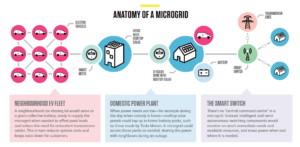Clean Energy Canada | The Great Grid Shakeup: Microgrids Invite Neighborhoods to Seize Control of Their Electrons
October 1, 2014

When used in combination, rooftop solar panels, power storage packs, electric vehicles, smart meters, and related equipment can make cities and neighbourhoods more resilient and efficient.
In the United States and elsewhere, universities and communities are knitting these local power generation and storage assets together to create microgrids—semi-autonomous neighbourhood electricity nodes. Microgrids allow businesses, homes, and schools in a given district to share power and resources as needed to help reduce peak loads—such as a surge in air conditioning during a heat wave—or keep the lights on for essential services during a blackout caused by severe weather, such as an ice storm.
Though there are few microgrids in Canada, in the United States, microgrid capacity stands at 1,051 megawatts and is expected to reach approximately 1,843 megawatts by the end of 2017. Legal and social barriers are keeping the microgrid as more of a concept than a reality in Canada, but all the technologies exist to deliver on its promise. This graphic explains how they work.
Excerpted from from Tracking the Energy Revolution – Global 2014.